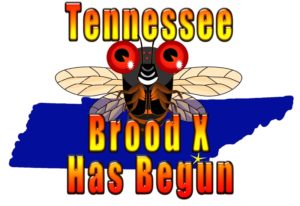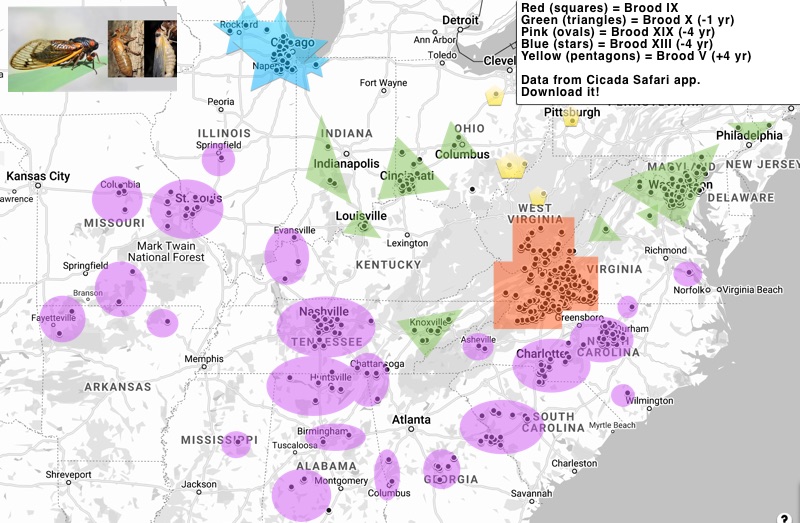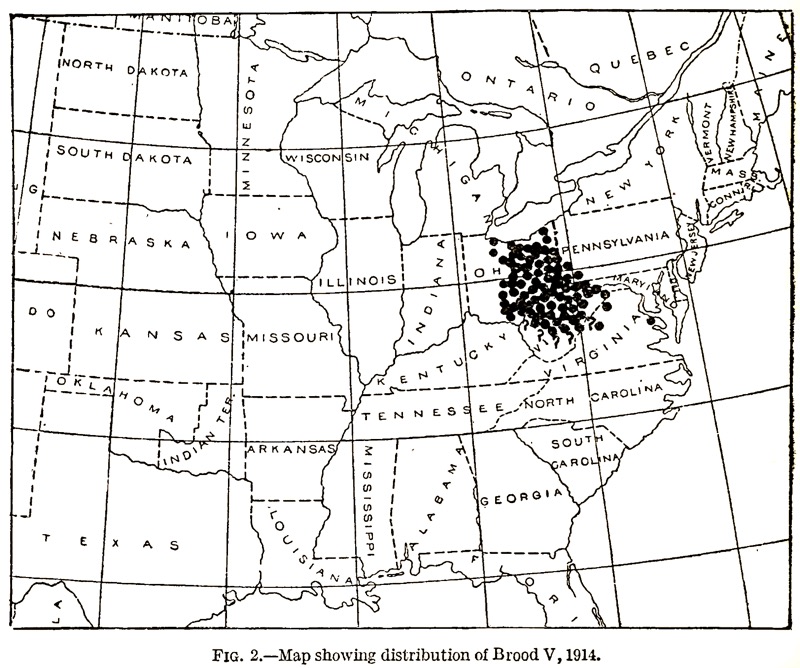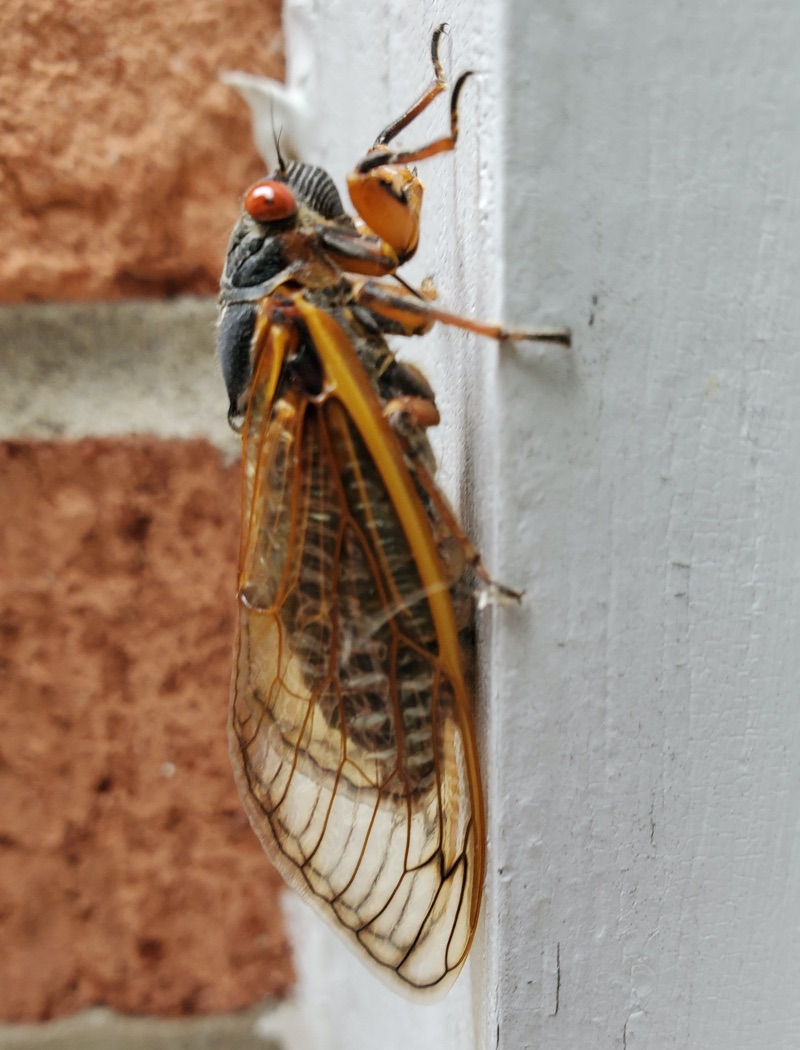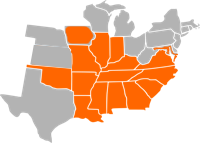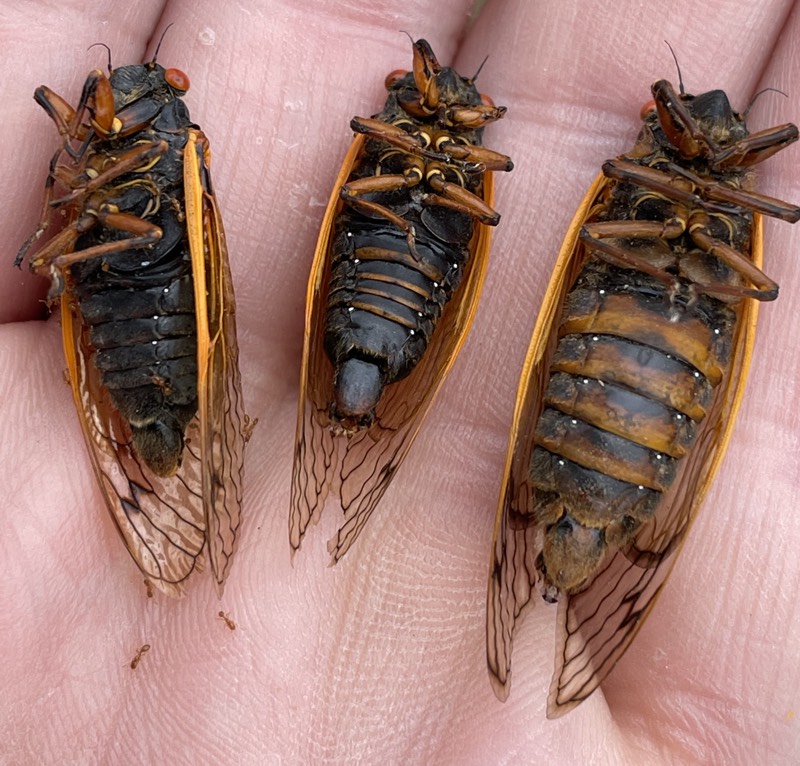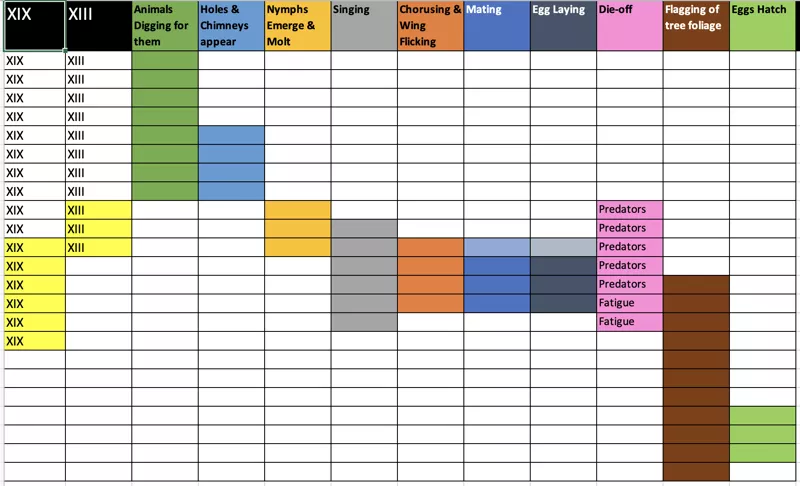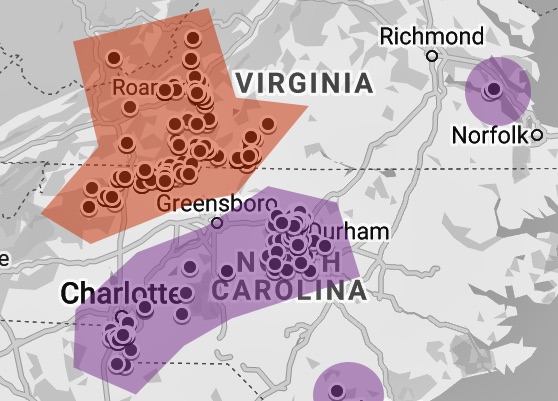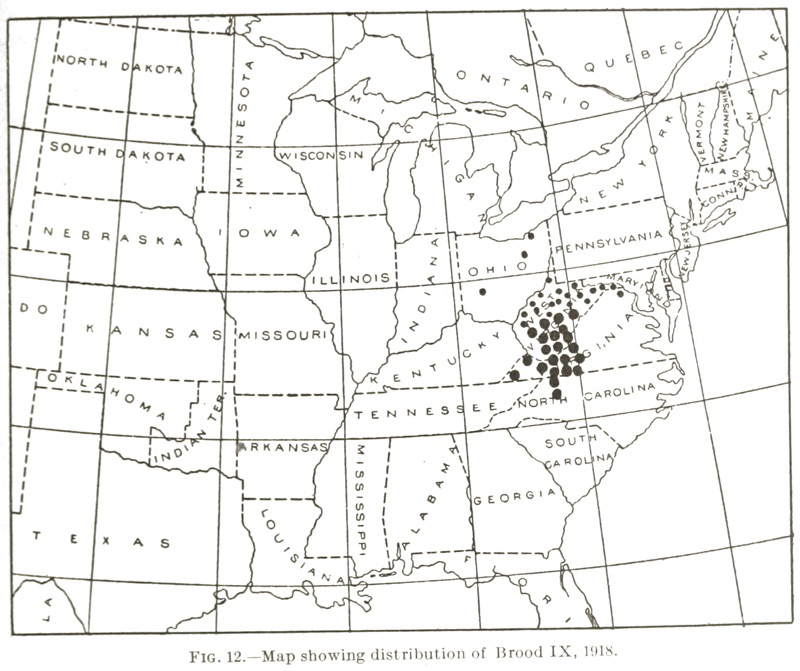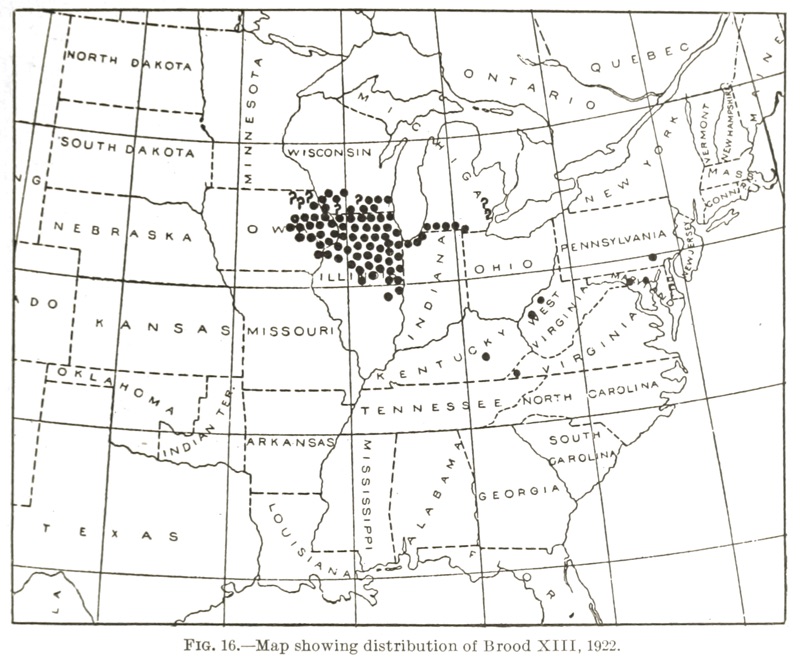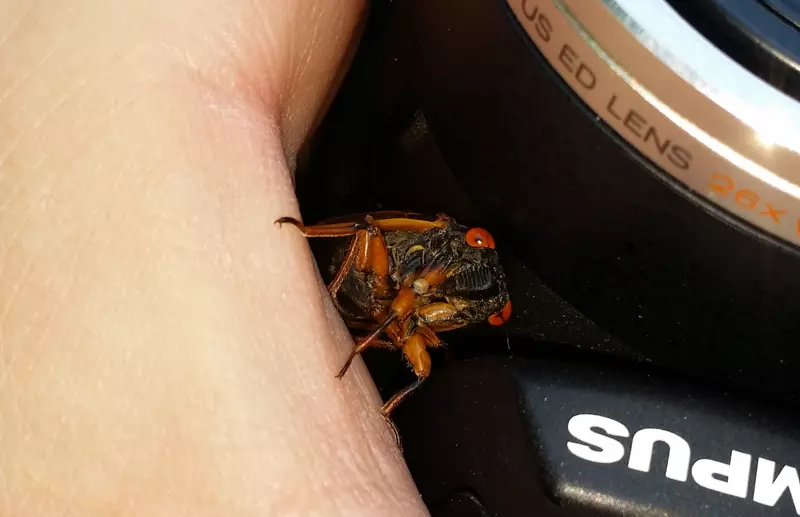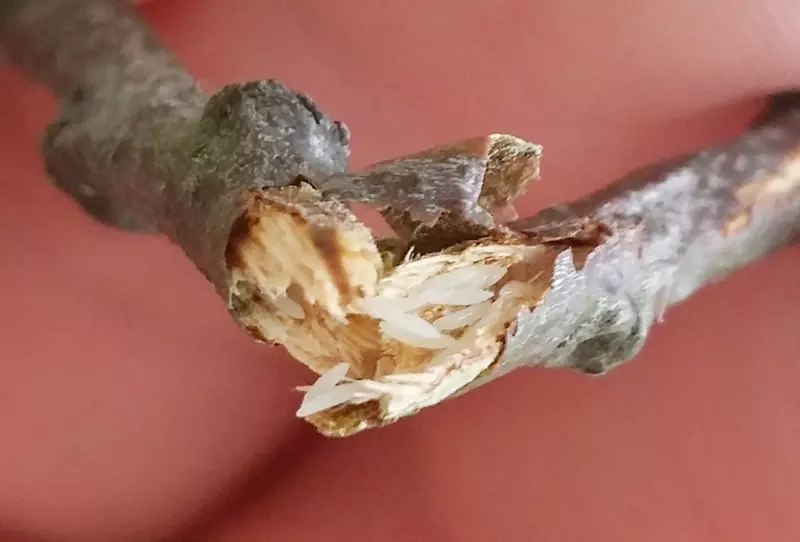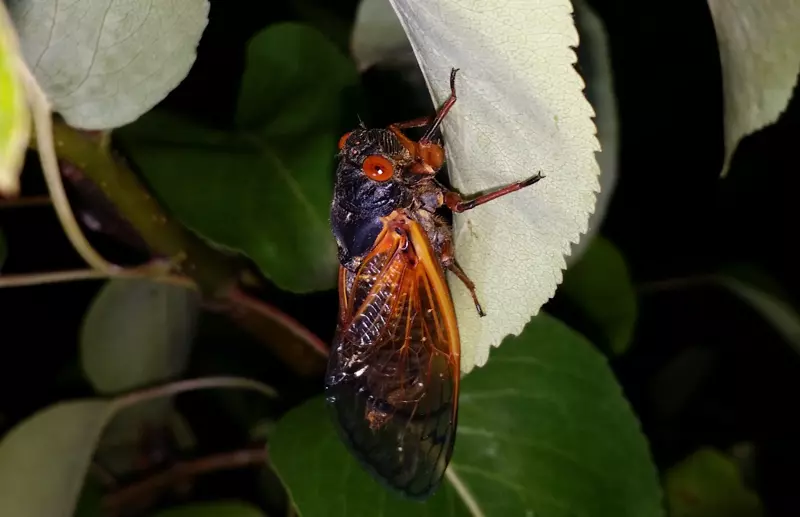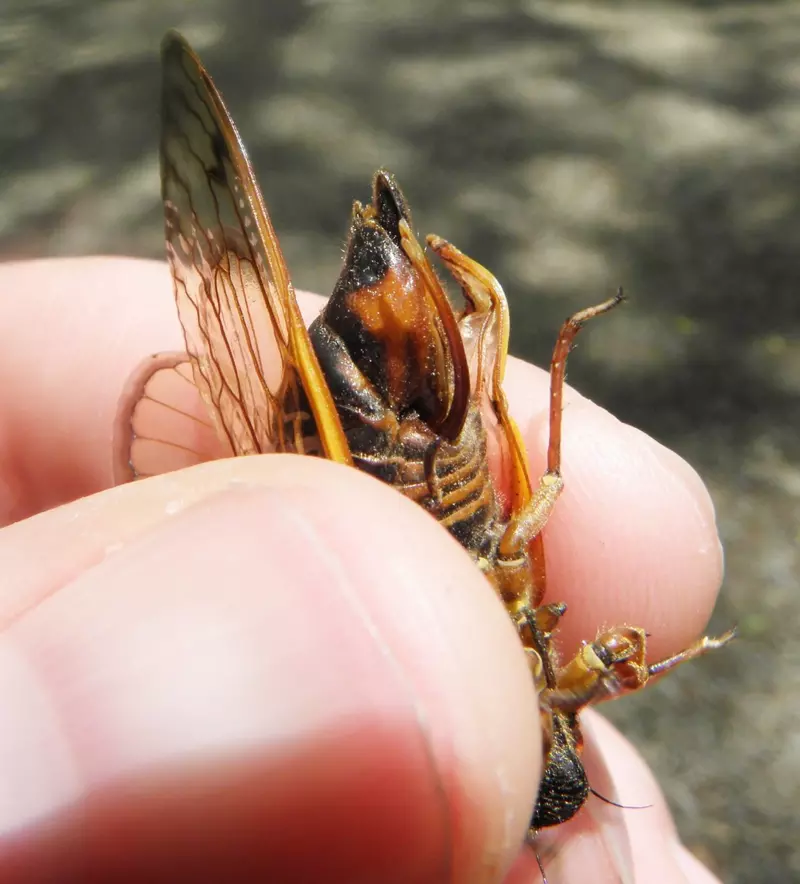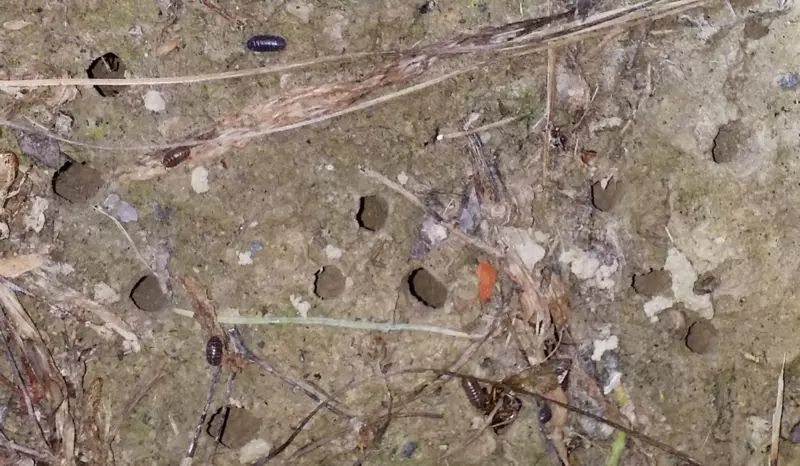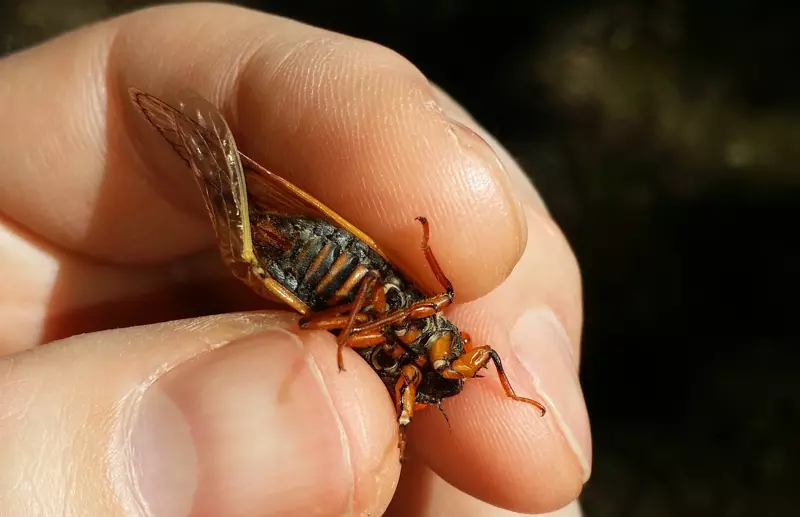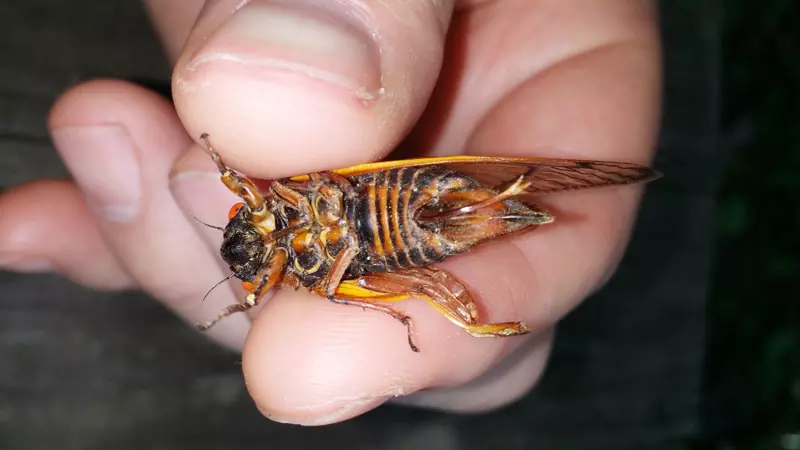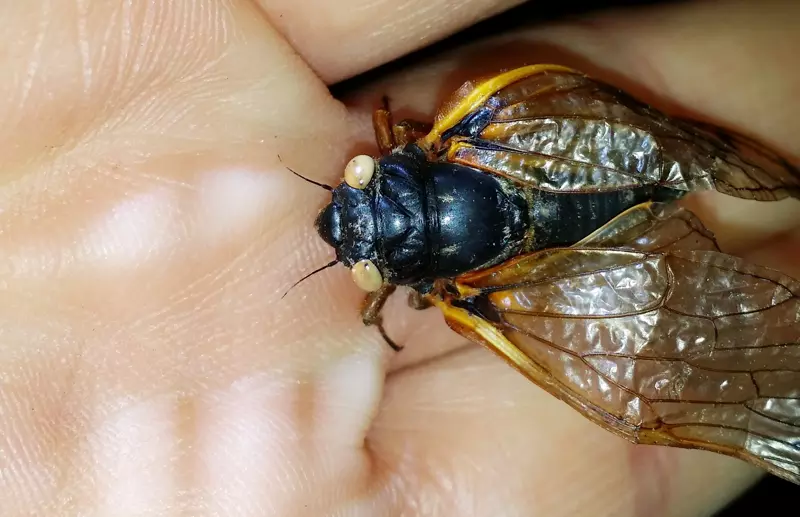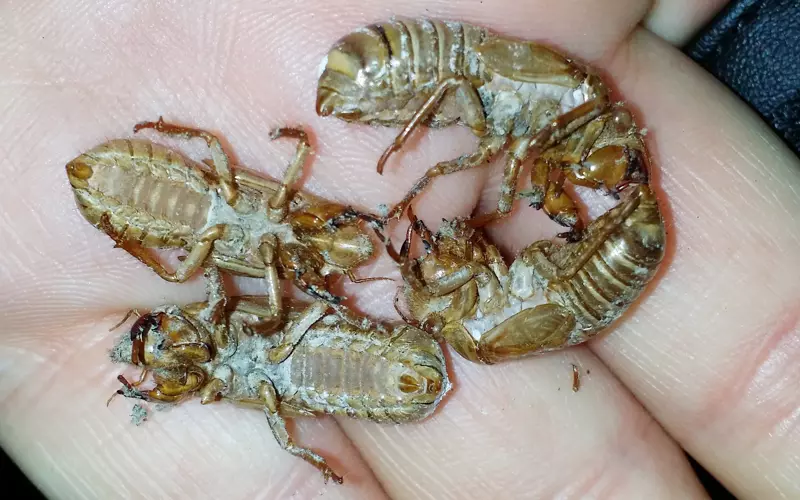
Brood X emerged in Delaware, Georgia, Illinois, Indiana, Kentucky, Maryland, Michigan, North Carolina, New Jersey, New York (not yet extinct), Ohio, Pennsylvania, Tennessee, Virginia, West Virginia, and Washington D.C. Report them with the Cicada Safari app. Use the hashtag #BroodX or #BroodXCicadas on social media.
LATEST NEWS:
Enjoy this video from 2021:
12/27/21: Dr. Gene Kritsky’s retrospective on the 2021 Brood X emergence has been published on the America Entomologist website.
In the news:
- NJ.com: Cicadas invade N.J. town where aliens landed in ‘War of the Worlds’.
- New York Times: The Case of the Disappearing Cicadas
- Bloomberg CityLab: To Map Billions of Cicadas, it Takes Thousands of Citizen Scientists
- NJ.com: Big 2021 cicada invasion hasn’t started yet in N.J., but some early cicadas have arrived
- Washington Post: Get ready! We predict cicadas will begin emerging next week.
- c|net: Billions of bugs: Meet the cicada chasers trailing Brood X.
- Fstoppers: Photographers Should Put This on Their Calendar Right Now: The Brood X Cicada Storm in Eastern U.S.
Interesting merch:
- A nice Magicicada pin by Carolyn Belefski
- A Brood X Cicada Notebook for documenting your cicada experiences.
- Cicadas Don’t Scream Activity Book.
- Gene Kritsky’s Periodical Cicadas: The Brood X Edition
- Sue Fink’s Cicada Suite (music) comes with a cicada shaped flash drive.
Articles about Brood X, a retrospective:
- Brood X Magicicada photos by Jim Occi taken in Princeton, set 6
- Brood X Magicicada photos by Jim Occi taken in Princeton, set 5
- Brood X Magicicada photos by Jim Occi taken in Princeton, set 4
- Brood X Magicicada photos by Jim Occi taken in Princeton, set 3
- Magicicada cassinii photos from Brood X
- Examples of flagging from Brood X in Princeton
- Brood X Magicicada photos by Jim Occi, set 2
- Brood X Magicicada Photos by Jim Occi
- Brood X 2021 Princeton, New Jersey
- Brood X in Grover’s Mill, West Windsor & Plainsboro, New Jersey
What, when, where, and why:
What are these cicadas?
Billions of these insects:
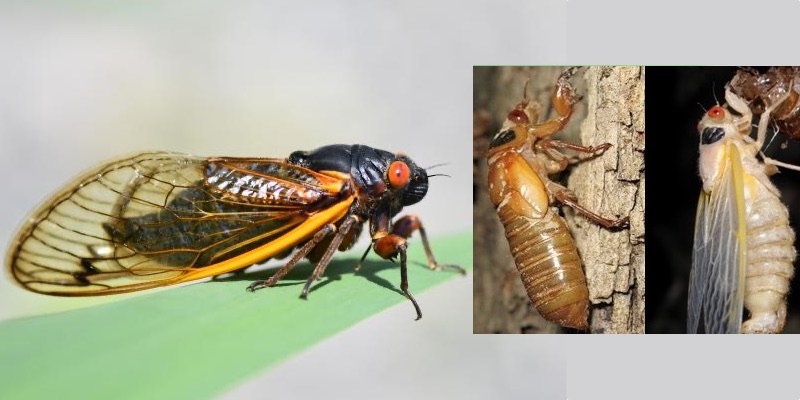
- Black, orange and red Cicada insects with a 17-year life cycle.
- Some people call them “locusts” but they’re really cicadas.
- Which species: All three 17-year species, Magicicada septendecim, Magicicada cassini and Magicicada septendecula. How to tell the difference between the species.
- NOT the green ones that arrive annually.
When will these cicadas emerge:
Typically beginning in May and ending in late June. These cicadas will begin to emerge approximately when the soil 8" beneath the ground reaches 64 degrees Fahrenheit. A nice, warm rain will often trigger an emergence. Back in 2004, people began reporting emergences around May, 13th, but if the weather is warmer, it might start in late April. Update: in 2021, they started in Tennessee on 4/27.
Other tips: these cicadas will emerge after the trees have grown leaves, and, by my own observation, around the same time Iris flowers bloom:
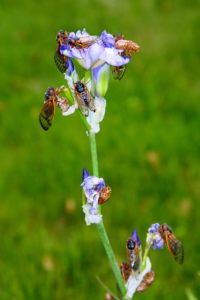
Where will these cicadas emerge:
Cicadas @ UCONN has the most up to date map. If you see a cicada and want to report it, the Cicada Safari App is available for Android and Apple devices .
Here’s my list from 2004. Green highlight means adults have emerged in 2021!
Delaware:
Delaware counties: Kent, New Castle, Sussex.
Delaware places: Newark, Wilmington.
Georgia:
Georgia counties: Gilmer, Murray, Union, White, .
Georgia places: Blairsville, Blue Ridge, Chatsworth, Ellijay, Fort Mountain State Park, Norcross.
Illinois:
Illinois counties: Edgar, Clark, Cook, Crawford, Vermilion.
Illinois places: Marshall, Park Forest, University Park.
Indiana:
Indiana counties: Brown, Clark, Clay, Columbus, Crawford, Daviess, Dearborn, Dubois, Fountain, Gibson, Greene, Jackson, Jefferson, Jennings, Lawrence, Marion, Martin, Monroe, Montgomery, Morgan, Orange, Owen, Parke, Perry, Pike, Ripley, Spencer, Sullivan, Vanderburgh, Vigo, Warrick, Waveland, Washington.
Indiana places: Aurora, Bloomington, Brookville, Clinton Falls, Dillsboro, Fishers, French Lick, Henryville, Indianapolis, Lawrenceburg, Lexington, Martinsville, McCormick’s Creek State Park, Nashville, New Pelkin, North Vernon, Salem, Skiles Test Park, Spencer.
Kentucky:
Kentucky counties: Boone, Breckenridge, Bullitt, Carroll, Daviess, Gallatin, Grayson, Hardin, Henry, Jefferson, Livingston, La Rue, McLean, Muhlenberg, Nelson, Ohio, Oldham, Trimble.
Kentucky places: Big Bone Lick State Park, Covington, Dayton, Dry Ridge, Eastview, Florence, Ft. Thomas, Georgetown, Grand Rivers, Hebron, Highland Heights, Louisville, Newport, Villa Hills.
Maryland:
Maryland counties: Allegany, Anne Arundel, Baltimore, Carroll, Cecil, Frederick, Garrett, Harford, Howard, Montgomery, Prince Georges, Washington.
Maryland places: Abingdon, Annapolis, Aspen Hill, Baltimore (learn about the Baltimore Cicada Art project), Bel Air, Beltsville, Berwyn Heights, Bethesda, Bowie, Brooklandville, Brooklyn Park, Catonsville, Chevy Chase, Clarksville, Clinton, Colesville, College Park, Columbia, Cockeysville, Crofton, Cumberland, District Heights, Eldersburg, Elkridge, Elkton, Ellicott City, Fair Hill, Fallston, Forestville, Four Corners, Gaithersburg, Gambrills, Germantown, Glen Burnie, Glenelg, Greenbelt, Gwynn Oak, Hagerstown, Hanover, Havre De Grace, Hillcrest Heights, Hunt Valley, Hyattsville, Hydes, Jessup, Kensington, Landover Hills, Laurel, Linthicum, Loch Raven watershed, Lutherville, Odenton, Oella, Onley, Owings Mills, Pikesville, Potomac, Randallstown, Reisterstown, Riverdale, Rockville, Severna Park, Sharpsburg, Silver Spring, Takoma Park, Timonium, Towson, Travilah, Wheaton, Woodbine.
Want a FREE cicada book? In the DC area? Visit Lulu Florist, 4801 St. Elmo Ave., Bethesda, MD, and ask for a free copy of Cicada: Exotic Views by Davy Shian.
Michigan:
Michigan counties: Hillsdale, Washtenaw.
Michigan places: Ann Arbor, Canton, Quincy.
New Jersey:
New Jersey counties: Burlington, Hunterdon, Mercer, Middlesex, Salem, Somerset, Warren.
New Jersey places: Alexandria, Allerton, Annandale, Asbury, Belle Mead, Bethlehem Township, Berkeley Heights, Bloomsbury, Browns Mills, Carpentersville, Clinton, Clinton Township, Cranbury, Delaware Township, East Amwell Township, Flemington, Franklin Park, Franklin Township (Somerset), Franklin Township (Warren), Frenchtown, Greenwich Township, Grover’s Mill, Hampton, Harmony, Hillsborough Township, Holland Township, Hopewell Township, Kendall Park, Kingston, Kingwood Township, Lambertville, Lawrence, Lebanon, Merrill Creek Reservoir, Milford, Montgomery, Monmouth Junction, Morristown, Mt. Rose, Pennington, Perryville, Phillipsburg, Plainsboro Township, Pittstown, Pohatcong Township, Princeton, Princeton Junction, Princeton Meadows, Prallsville, Raritan Township, Raven Rock, Readington Township, Ringoes, Rosemont, Rocky Hill, Skillman, Sourland Mountain, South Brunswick Township, Stanton, Stewartsville, Stockton, Union Township (Hunterdon), Voorhees Corner, West Windsor Township.
There’s an abundance of large parks and natural areas around Princeton.
New York (Long Island):
New York counties: Suffolk (but extinct, or nearly so, but still look for them – Newsday article).
New York places: All on Long Island, but based on the 2004 emergence, they might be extinct. Some were seen in East Setauket, Connetquot River State Park, Ronkonkoma, Stony Brook. In 1987 they were seen in Shirley, Ronkonkoma, Bohemia, Connetquot River State Park, Oakdale, and Setauket.
In Long Island? Please read this article!.
North Carolina:
North Carolina counties: Buncombe, Cherokee, Surry, Wilkes.
North Carolina places: Apex, Elkin, Morganton, Murphy, Roaring River, Weaverville.
Ohio:
Ohio counties: Butler, Clermont, Defiance, Franklin, Greene, Hamilton, Logan, Montgomery.
Ohio places: Amelia, Anderson Twp, Battelle Darby Park, Batavia, Bellbrook, Camden, Centerville, Cincinnati, Columbus, Defiance, Delaware, Delhi Twp, Dublin, Fairfield, Galloway, Hamilton, Kettering, Lewisburg, Lockland, Miamisburg, Olmsted Falls, Oxford, Paint Creek State Park, Springfield, St. Bernard, West Carrollton, West Chester.
Pennsylvania:

Pennsylvania counties: Adams, Bedford, Berks, Bucks, Chester, Columbia, County, Cumberland, Dauphin, Delaware, Franklin, Fulton, Huntingdon, Lancaster, Lehigh, Luzerne, Lycoming, Mercer, Montgomery, Northampton, Perry, Schuylkill, Somerset, York.
Pennsylvania places:Archbald, Artemas, Bedford, Carroll Valley, Coopersburg, Dinosaur Rock, Downingtown, Erwinna, Gettysburg, Green Lane, Kintnersville, Lake Nockamixon, Lancaster, Lititz, Lumberville, Malvern, Mertztown, Metal Township, Mohnton, Mt Gretna, New Hope, Oaks, Oley, Perkasie, Perkiomenville, Phoenixville, Pipersville, Pittston, Plumstead Township, Point Pleasant, Quakertown, Red Lion, Roaring Spring, Solebury Township, Spring Mount, Stewartstown, Tinicum Township, Topton, Uhlerstown, Upper Black Eddy, Warwick Park, Williams Township.
Special note for folks in the Philly area: Is Philly Being Snubbed Again?.
Tennessee:
Tennessee counties: Blount, Greene, Hamblen, Hamilton, Jefferson, Knox, Polk, Roane, Sumner, Washtington, Wilson.
Tennessee places: Benton, Copperhill, Farragut, Fayetteville, Knoxville, Oak Ridge, Powell, Signal Mountain.
Virginia:
Virginia counties: Arlington, Clarke, County, Dulles Smithsonian National Aircraft and Space Museum, Fairfax, Fauquier, Frederick, Loudoun, Shenandoah, Warren, Winchester.
Virginia places: Alexandria, Annandale, Arlington, Ashburn, Centreville, Chantilly, Clearbrook, Del Ray, Doswell, Dunn Loring, Fairfax, Falls Church, Franconia, Gore, Hampton Roads, Haymarket, Herndon, Lorton, Lovettsville, Manassas, McLean, Merrifield, Oakton, Reston, Springfield, Sterling, Vienna, White Post, Winchester.
West Virginia:
West Virginia counties: Berkeley, Grant, Hampshire, Hardy, Jefferson, Mineral, Morgan.
West Virginia places: Inwood, Martinsburg, New Creek, Paw Paw.
Washington D.C.

Washington D.C. places: Washington D.C.
Want a FREE cicada book? In the DC area? Visit Lulu Florist, 4801 St. Elmo Ave., Bethesda, MD, and ask for a free copy of Cicada: Exotic Views by Davy Shian.
More Location Tips:
- Reports of Brood X cicadas that emerged early in 2017.
- City data comes from May 2004 reports and June 2004 reports.
- Not sure? Ask someone in your community who lived there 17 years ago.
Example Emergence Timeline
This is an example of a typical cicada emergence. The exact dates will depend on the weather and density of the emergence in your location. Hot weather means an early start and quicker finish to the season — cool weather means a later start, and a protracted season.
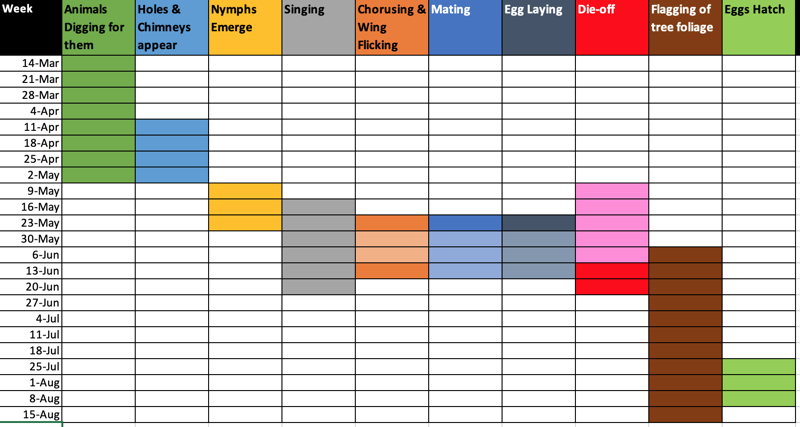
Here’s an Excel version of the chart. Feel free to use it and adjust it to match your experience.
Or watch the video version:
Some interesting things to look for
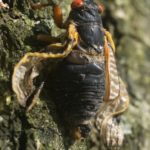
|
Lean why many cicada wings are striveled up or damaged. |
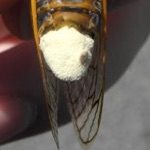
|
Learn about the Massospora cicadina fungus they share. |
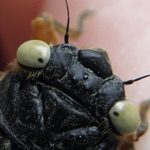
|
Look for cicadas with blue, white or other colored eyes. |
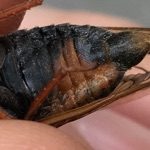
|
Look for Mosaic pigment disorders. |
Why do cicadas:
Why do they stay underground for 17-years? The prevailing research suggests they’ve evolved a long, 17-year lifecycle to avoid predators that can sync up with their lifecycle & emergence. Why are there so many?! Research suggests that their huge numbers allow them to overwhelm predators, so enough of them will live on to breed and perpetuate the brood.
Should you plant?
If you’re planting trees, wait until July. If your yard doesn’t get cicadas by the first week of June, it’s probably safe to plant in June. It’s the egg-laying that does damage. Talk to an arborist or tree expert if you’re actually concerned. I can’t answer your questions.
More facts and fun:
- New! Cicada Mania Crossword Puzzle. It isn’t easy.
- New! Cicada Mania Bingo!
- Use the correct image and the correct language when talking about these cicadas. Here’s some images you can share.
- Use the Periodical Cicada Emergence Checklist for the Maximum Magicicada Experience.
- All cicada questions that are frequently asked.
- A video to help you tell the difference between the species.
- The 17 Most Interesting Periodical cicada facts.
1907 Map from Marlatt, C.L.. 1907. The periodical cicada. Washington, D.C.: U.S. Dept. of Agriculture, Bureau of Entomology.
Things have changed since 1907. See the modern UConn Cicada Map, or the Live Map from the Cicada Safari app.
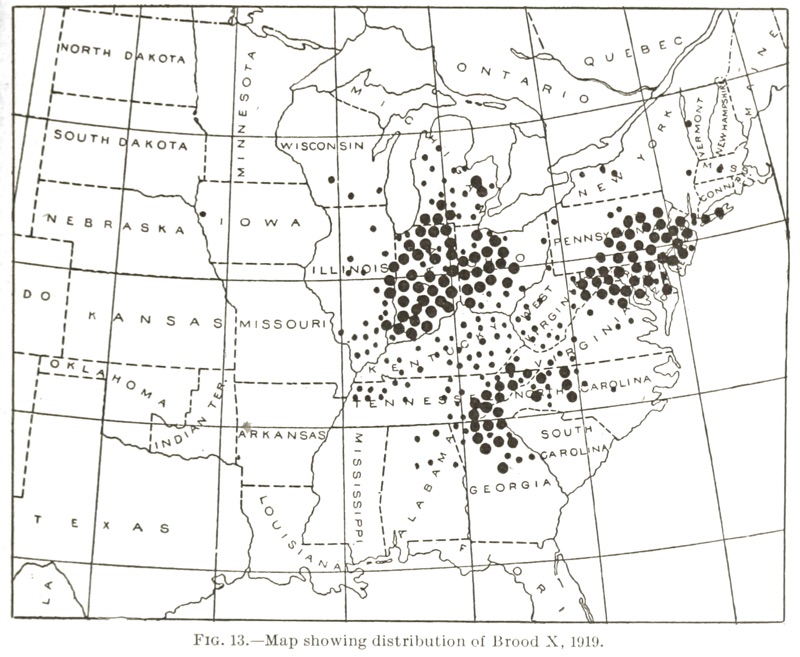
Leave a comment below, or join the Cicada Discussion & Science Group on Facebook.







